Home
A comprehensive resource for safe and responsible laser use
US: Protester accused of aiming laser at officers' eyes has felony charges dropped on technicality
An additional six counts of aggravated misdemeanor assault, related to the felony counts, can proceed since they were filed on time.
The protester is accused of aiming a laser at the eyes of several University of Iowa police officers during an August 31 2020 protest in Iowa City. The officers reported temporary vision loss, headaches and "other health problems."
To convict on the misdemeanor counts, prosecutors will have to show that the protester intended to inflict serious injury on the officers when he aimed a laser at them.
The 25-year-old protester was named Matthew Bruce at the time of the protests, and said he has since changed his name to Mate Farrakhan Muhammad.
From The Gazette and the Des Moines Register
US: 113 federal agents in Portland said to be injured by protesters' lasers; none were permanently blinded
All officers recovered their sight, according to deputy director Ken Cuccinelli, speaking on August 4 2020. This appears to include the "three officers who currently have eye injuries and [who] may not recover sight." This statement was said on July 21 2020 by a Federal Protective Services official. (FPS is a division of DHS.) Some persons who repeated this, such as the White House press secretary and the Attorney General, repeated the "may not" qualifier, while others — generally news or commentators — said flatly that officers were permanently blinded.
Cuccinelli said "We've had a number of officers who have days-long blindness. So far they've all come back, if you will. But you also get what's called flash blindness … where you can't quite see your entire field of vision for a period." [As explained below, flash blindness is not an "eye injury" and should not have been included in the total of 113 "eye injuries.]
Cuccinelli told the Judiciary Committee's Subcommittee on the Constitution that protesters began aiming at police from closer distances. Since laser beams spread out, this reduces the spread and thus increases the hazard potential. Protesters do this, he said, so police cannot identify suspects.
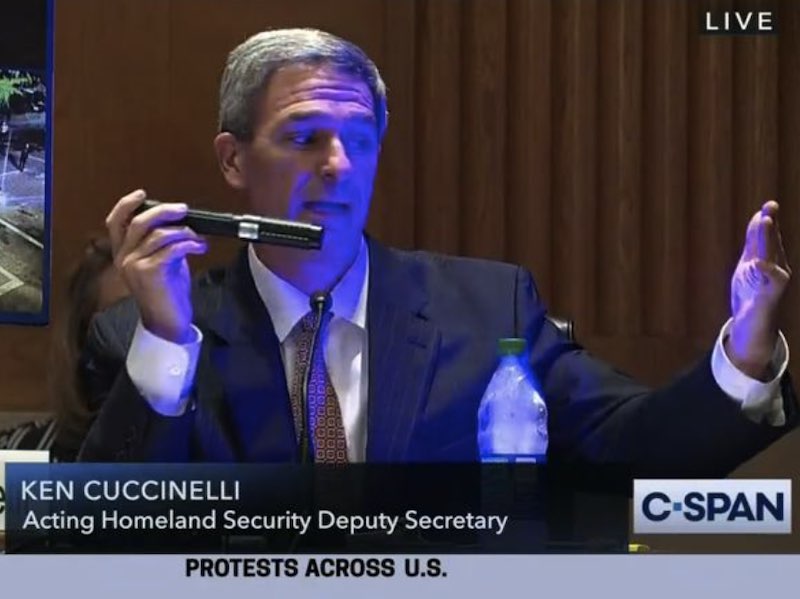
Cuccinelli demonstrated what he called a "commercial grade" laser by aiming it into his hand and saying it got hot within a second or two. He said such a laser could be purchased on Amazon.com.
US: Three officers in Portland may be permanently blinded
Claims of eye injuries
Officers were attempting to defend the building. "When [Federal Protective Service] officers responded to put out these fires, glass bottles were thrown and lasers – which can cause permanent blindness – were shined in their eyes. We have three officers who currently have eye injuries and they may not recover sight in those eyes from those laser attacks," said FPS Deputy Director of Operations Richard Cline.
The assertion was repeated on July 24 by White House press secretary Kayleigh McEnany: "….tragically, three federal officers were likely left permanently blinded by the rioters using lasers pointed directly into their eyes." On July 28, Attorney General William P. Barr, testifying before the House Judiciary Committee, wrote in his prepared remarks that "A number of federal officers have been injured, including … three who have suffered serious eye injuries and may be permanently blind."
Some news sources and commentators stated flatly that the officers are permanently blind. Lost or ignored was the fact that there was only one official statement on the prognosis ("they currently have eye injuries and they may not recover sight").
Reporters noted red, green and purple laser beams aimed at officers through the courthouse doors. At least one person may be charged. According to the Associated Press, "[c]ourt papers in a federal case against a man accused of shining a laser in the eyes of Federal Protective Service agents show that Portland police turned him over to U.S. authorities after federal officers identified him." ProPublica reported that the charging documents said an agent "reported seeing spots in his eyes for 15 minutes after the laser attack. [As of November 9 2020, LaserPointerSafety,com is aware of two cases against individuals, one from June 2020 and one from August 2020.]
Force authorized against laser attacks
In response, Customs and Border Protection has authorized the use of "less-lethal force" against protesters with lasers. CBP said in a memo that pepper spray balls or beanbag shotguns are allowed because lasers aimed at eyes or through camera lenses are "remarkably dangerous because of their concentrated energy."
Protesters using lasers would first be issued a verbal warning. Then CBP agents targeted would decide whether less-lethal force is justified. The calculation should be based on the crime committed and the level of danger.
“Officers/agents are authorized by law to use objectively reasonable force to effect the arrest and protect against harm to the officer/agent or others,” wrote Charles A. Bishop, who oversees the agency’s law enforcement compliance directorate. “Officers/agents should consider all reasonable tools, tactics and equipment to cease an assault with a handheld laser in accordance with CBP Use of Force Policy and U.S. constitutional standards.”
Bishop said without a threat of serious bodily injury or death, “CBP does not recognize the threat of handheld visible lasers as one that would require a deadly force response.”
Eyewear purchased to defend against lasers
To defend themselves the Federal Protective Service is buying 1,000 pairs of Stingerhawk FT-2 Laser Protective Eyewear from Revision Military. In its sole-source contract document dated July 10 2020, FPS said "readily accessible and affordable" lasers can cause dark spots, hazy vision, headaches or retinal bleeding. The contract also noted that Seattle police officers who used laser-resistant glasses "expressed that they were very effective."
From Fox News (initial blinding report), the New York Post (White House statement), Politico (AG Barr statement), the Associated Press via MSN (court papers), ProPublica (15 minutes of spots), the Washington Times (CBP response), Williamette Week (FPS eyewear)
For more information, see the page Laser use during protests and LaserPointerSafety.com news articles about non-laser eye injuries during protests.
UPDATE AUGUST 4 2020: The three officers said to possibly have permanent blindness appear to be OK, with their sight recovered. In Senate testimony, a Department of Homeland Security official said there were 113 eye injuries to federal officers in Portland, and "[s]o far they've all kind of come back". The Federal Protective Service is part of DHS, so the official's statement would have included the three injured officers.
Hong Kong, China: UPDATED - Widespread use of laser pointers during protests
Protests against increased Chinese control of Hong Kong began in March and April 2019. On June 21, lasers were aimed at police officers' eyes.
The use of lasers increased dramatically after the August 6 2019, arrest of 20-year-old Hong Kong Baptist University student union president Keith Fong for having 10 laser pointers. (According to the South China Morning Post, laser pointers are readily available for less than HK $100 [USD $13].) Fong claimed he purchased them for stargazing. Persons around him chanted "release him" but police arrested him for "possession of offensive weapons.”
Police said that laser pointers are not prohibited in Hong Kong, but if they are used in an attack or are intended for use in an attack, then they are considered offensive weapons. During an August 7 2019 press conference, Li Kwai-wah, Superintendent of the Organized Crime and Triad Bureau said “…many of our colleagues have been injured by these items. And sensors in some of our video cameras were damaged. So we strongly believe that these items, which are capable of hurting people and destroying things, are indeed ‘offensive weapons.’” Police then demonstrated how the blue beam from a pointer taken from Fong could cause black ink on a newspaper to begin smoking at a range of about 20 inches.
Fong’s arrest set off demonstrations and a rally to demand his release. Critics of the police arrest said Fong’s laser pointers were legal unless they were actually being used to attack. The protests were marked by widespread use of laser pointers. At one point, a protester held up a newspaper and dozens of lasers were shined on it, without affecting the paper. (This was to show how laser beams as used in demonstrations — at distances much longer than 20 inches and handheld onto uncooperative targets — would not have the same effect as holding a beam steady on an unmoving target at close range.)
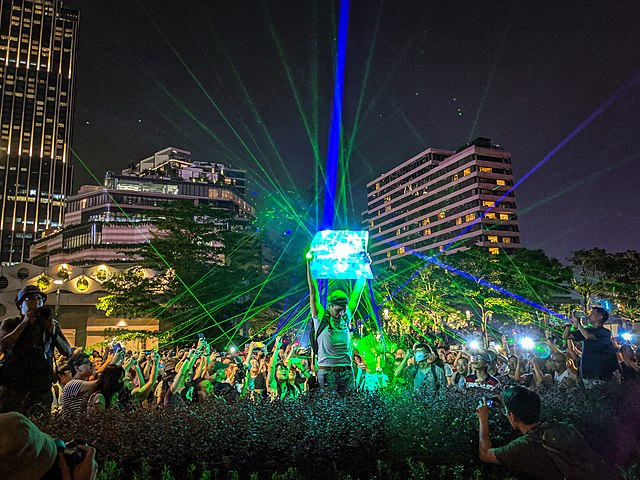
Studio Incendo via Wikipedia, cc-by-2.0
Protesters also aimed their laser pointers at the dome of the Hong Kong Space Museum, creating a "laser show" that may have been a takeoff on the nightly "Symphony of Lights" show around Hong Kong's harbor.
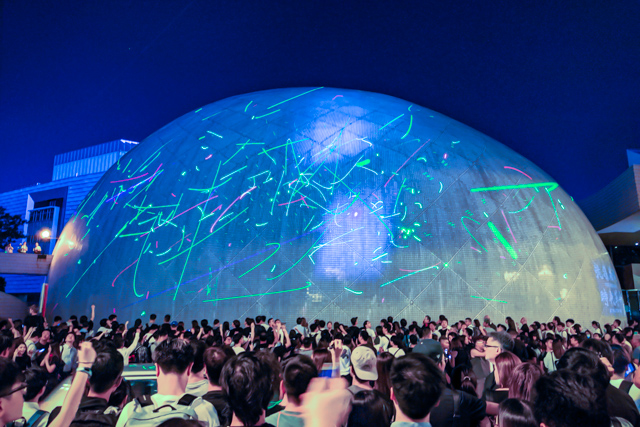
Protesters at the Hong Kong Science Museum. Studio Incendo via Wikipedia, cc-by-2.0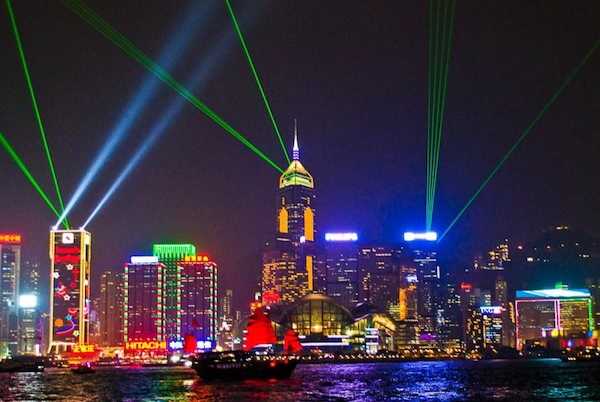
Hong Kong Symphony of Lights laser show, presented nightly at 8 pm by the Hong Kong Tourism Board.
According to Wikipedia, during the laser pointer protest "some chanted slogans like 'laser pointer revolution' and joked 'Is the building on fire yet?' They hoped to show support to Fong and voice condemnation of his arrest by police, and to show that laser pointers are neither offensive weapons nor effective enough to cause a fire." A writer tweeted that the mood was festive: "This is the joyous, comedic side of [the protests] I’ve been missing amid the miasma of tear gas. Tonight was something we all needed: no tears, no blood, just laughter, song, and dance.”
Fong was released on August 8 2019, after being detained for two days.
Use of laser pointers continued in subsequent protests. For example, on August 10 a female flight attendant, Kwok Lai-fan, 28, was arrested for assaulting a police officer using a laser pointer.
On August 13, during demonstrations that closed Hong Kong airport, a person was beaten by protesters. According to Global Times, "the rioters began assaulting him by cuffing his hands behind his back, splashing water on his head and pointing laser beams into his face. He was denied medical help for hours until being rescued at around 10:40pm by Hong Kong police."
On August 14, lasers were aimed at a police station in the Sham Shui Po area of Kowloon. Police responded by firing tear gas to disperse the group.
On November 7, a 16-year-old boy was the first person convicted of possessing a laser pointer at the protests. During the trial, an expert testified that a laser pointer could injure eyes depending on the distance to the victim and the length of time the laser was in the victim's eyes. The judge said the boy's use of the pointer "was meant to harm the eyes of police officers, causing them discomfort." He ruled the pointer was not inherently an offensive weapon, but could become one depending on the circumstances and intent. On or around November 26, the unnamed teen was sentenced to attend a rehabilitation center where he will serve a short custodial sentence and receive work training and counseling.
For more photos and information, see the page "Laser use during protests"
From Vice News (Aug. 8 2019 story about "All-Night Laser Party"), South China Morning Post (Aug. 7 story, "Hongkongers rally to demand release of student arrested over possession of laser pens"; Aug. 8 story, "Laser pointer as 'weapon', explained"; Aug. 12 story, Flight attendant, audio technician and security guard among those arrested during another weekend of Hong Kong protests; Nov. 7 story "Boy, 16, is first to be convicted of possessing laser pointer at Hong Kong protests"), CBC News (Aug. 11 story, "Hong Kong protesters use laser pointers to deter police, scramble facial recognition"), Infosurhoy (Aug. 13 story, "Hong Kong protesters gather for 'laser show' rally"), Washington Post (Aug. 14 story, "After airport mayhem, Hong Kong protesters face tipping point in battle for hearts and minds"), Global Times (Aug. 14 story, "Netizens furious over rioters' assault of mainland passenger at HK airport"), Wikipedia article on "2019 Hong Kong anti-extradition bill protests" accessed August 14 2019, Hong Kong Free Press (Nov. 26 story, "Hong Kong court sends 16-year-old to rehab for carrying laser pointer, hiking pole and modified umbrella at demo")
UPDATES
On May 20 2020, the 16-year-old boy mentioned above (Nov. 7 2019) lost his appeal. The judge concluded the lower court was correct to characterize his carrying a laser pointer as an "offensive weapon" under Hong Kong law.
On July 23 2020, a man was sentenced to 100 hours of community service for aiming laser beams at a police station near his house. The beams were not related to the protests; we are reporting it here since he was originally charged with violating a Hong Kong law stating that lasers are offensive weapons.
On July 24 2020, a man was acquitted of a charge of possessing offensive weapons including a baton and a laser pointer.
Canada: UPDATED - Laser beams aimed at police during St. Patrick's Day riot
The 5-hour confrontation began the evening of March 17 2012. St. Patrick’s Day parties “spilled into the street” in an area near Fanshawe College. The crowd grew to about 1,000 people. A brush fire was started, and a CTV news truck was set on fire. To slow fire crews, some persons threw beer bottles, bricks, wooden planks, tires, rim and other debris. In addition, said London’s police chief, “members of the crowd used laser pointers aimed at our officers’ eyes to try to disrupt our response.” A spectator said that the crowd, made up primarily of students, “wanted to egg on the police.”
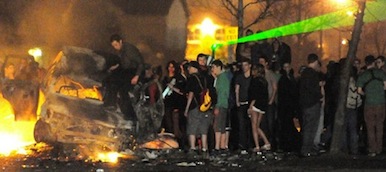
A person aims a laser during the London, Ontario riot. From a photo gallery at The Star.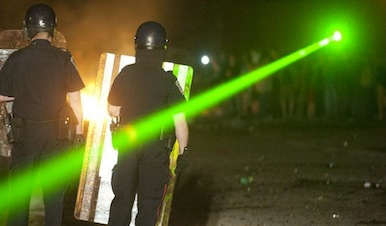
From the Toronto Sun. This is possibly the same laser beam; note glow from fire to the left, behind the officers.
The full extent of the laser misuse is not known. While the police chief indicated there were multiple lasers involved, the National Post said “One rioter attempted to blind the officers with a high-powered green laser.” Media reviewed by LaserPointerSafety.com found a single laser being used in each photo or video. Although some bystanders and police suffered minor injuries from thrown objects during the rioting, there were no reports of laser-caused eye effects or injuries. Eleven persons were arrested at the scene; charges included assaulting police. It is not known if any laser assault charges were brought.
Similar riots occurred in the same area of Fleming Drive in 2007 and 2009, blamed on a high concentration of alcohol-fueled Fanshawe students. The 2012 riot is expected to cost London $100,000 in manpower and repair costs.
From CBC News, Globe and Mail, Toronto Sun, The Star, and the National Post. Thanks to Mathieu Gauthier for helping bring this to our attention.
UPDATED, April 20 2012: Thirty-eight people are facing a total of 85 charges in the incident, thus far. Brian Nuccitelli, 18, faces three charges including two relating to misuse of a laser pointer: “possessing a weapon dangerous to public peace” and “assaulting a police officer with a weapon”. Police said the pointer was aimed at officers’ faces. They said “one officer was injured and continues to receive medical attention as the result of the laser being directed at his eyes.” In addition to Nuccitelli, police are also looking for another person who aimed a laser at officers. From lfpress.com